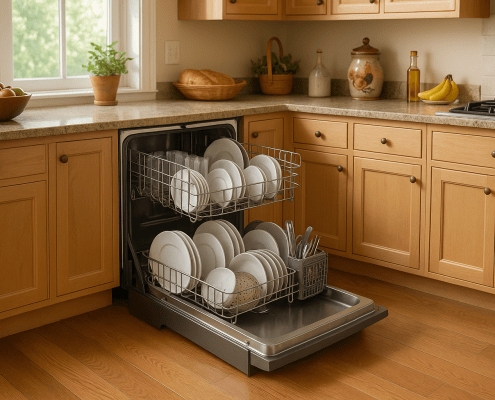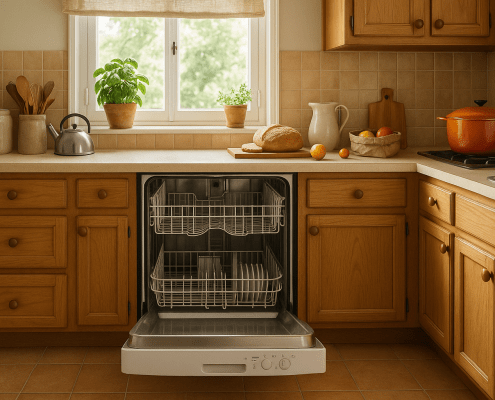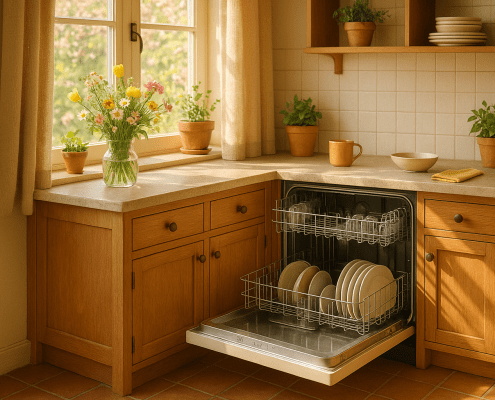DIY GE Dishwasher Control Panel WD34X22262 Replacement Guide
Steven E / Wednesday May 14, 2025
Is your trusty GE dishwasher suddenly unresponsive or flashing error codes? The control panel might be the culprit, but don’t worry—it’s a straightforward fix you can tackle yourself! Keep reading to discover how to replace it, and watch our step-by-step video guide for a seamless repair experience.
Looking for the right part? Enter your appliance model number below to find the exact match and get your appliance running like new again!
Is your GE dishwasher ignoring your commands or flashing error codes? The control panel might be the issue and part WD34X22262 is the fix. Whether the buttons aren’t responding or the display’s gone dark, swapping out the control panel is a surprisingly simple DIY repair. Grab a screwdriver and let’s get your dishwasher back to working again.
The information in this article may not apply to your specific appliance model. We recommend consulting your manufacturer’s documentation or contact us with any questions.
Watch: How to replace a dishwasher control panel
Safety Tips
Safety comes first when working on any appliance. Here are some practical tips to help keep you safe:
- Always turn off the power by unplugging the appliance or switching off the circuit breaker before starting. This protects you from the risk of electric shock.
- Wear insulated gloves to protect your hands from sharp edges, pinching hazards, or debris.
- Take your time and work at a steady pace to avoid accidents or injuries.
- Make sure your workspace is well-lit so you can clearly see and access the parts you’re working on.
- Keep your area organized and free of clutter, and ensure children and pets are kept away from the workspace.
- Never handle internal parts with wet hands. Make sure both your hands and the work area are completely dry.
- Check your appliance’s user manual for specific instructions or safety guidelines related to your repair.
- Handle parts gently to prevent damaging the appliance or injuring yourself by using too much force.
- Wear safety glasses if you’re dealing with chemicals, dust, or large debris to protect your eyes.
- If the appliance was recently used, give it time to cool down before working on any heated components.
- Take photos or notes of wiring connections before disconnecting anything. This makes reassembly much easier.
- Avoid touching exposed wires or terminals. If you need to handle wires, use non-conductive tools or wear insulated gloves to reduce the risk of electrical shock.
Gather Your Supplies
You’ll want to have the following tools and parts on hand before taking apart your dishwasher:
- Phillips head and flat head screwdrivers – for removing screws
- 1/4 inch nut driver – for taking off brackets
- Needle nose pliers – for disconnecting wiring connections
- Wrench set – to loosen water lines
- Wire cutters/strippers – just in case electrical work is needed
- Replacement control panel – check the model number for the right part
- Flashlight – to see into tight spaces
- Towels – for cleaning up spills
- Protective gloves – to keep hands safe
With all that assembled, you’re ready to get elbows deep into dishwasher repair.
Removing the Dishwasher
The first step is accessing the inner workings – which requires pulling the dishwasher out from the cabinetry.
- Turn off the power and water supply.
- Remove the lower access panel with a Philips screwdriver. Place the screws aside for safekeeping.
- Disconnect the fill line from the valve under the sink using pliers or a wrench.
- Disconnect the drain hose from the air gap/disposal using flat head screwdriver.
- Remove mounting screws along the upper cabinet lip with a Philips screwdriver.
- Pull the dishwasher out carefully, lay down a towel to catch drips.
With the unit pulled out, you can now start dismantling the door.
Removing the Door
The control panel is housed on the inner door, so the outer door has to come off first.
- Pry off the trim piece along the bottom edge of the door.
- Disconnect the connector plug for the control panel so the door can separate completely.
- Release the door by pressing the tabs on either side near the hinge.
- Lift the door up and off the unit, and place it on a towel.
Be gentle so you don’t bend or warp the door panels. Now we can focus on the control panel itself.
Removing the Old Control Panel
With the door off, you can access and remove the old control panel.
- Remove the screw caps along the perimeter of the panel using a flat-head screwdriver.
- Take out the mounting screws with a Phillips screwdriver.
- Carefully pry the panel loose, releasing the plastic clips.
- Disconnect any wire connectors going to the panel (note their locations or take pictures to help with reassembly).
- Lift the panel up and out of the door cavity.
Inspect the panel and mounting bracket for any cracks or damage. Now we’re ready for the new part.
Installing a New Control Panel
- Connect any wires and connectors to the panel.
- Insert panel into bracket slots and press in firmly so all clips catch.
- Replace the perimeter screws and screw caps.
- Reconnect any wiring to the panel.
Make sure the gasket sits flush and makes a good seal. Now to get the door back on.
Reassembling the Dishwasher
The final steps are to reattach the door and push the dishwasher back into place:
- Set the inner door panel back into the outer door.
- Lift the door up to reattach the hinges and close.
- Replace the trim piece along the bottom of the door.
- Push dishwasher back, aligning rails.
- Secure with upper mounting screws.
- Reconnect the fill line and drain hose.
- Replace the lower access panel.
With that, you can restore power and water supply. Run a test cycle to verify the new control panel functions properly before loading dishes.
Wrapping Up
If you need any replacement parts for your appliances, you can enter your model number at AppliancePartsPros.com to locate and order them quickly. Most orders arrive in just two business days, and we have tons of great information in our repair help section and YouTube videos to help you troubleshoot.
Stay connected with the latest DIY tips, tutorial videos, and repair guides by following us on Facebook, Instagram, and Twitter. We love hearing about your repair stories and successes. If you need more help or want personalized guidance, feel free to reach out. We’re ready to help you take on your next project with confidence!
With nearly a decade of experience in providing top-notch customer service regarding appliance parts and repair, Steven enjoys sharing practical advice, troubleshooting tips, and interesting information to help readers stay informed.





